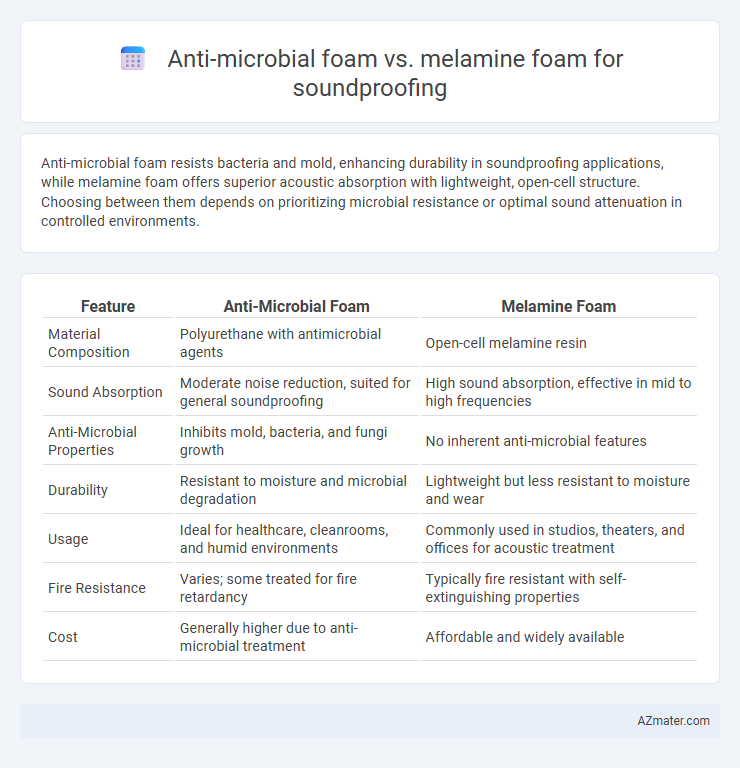Anti-microbial foam resists bacteria and mold, enhancing durability in soundproofing applications, while melamine foam offers superior acoustic absorption with lightweight, open-cell structure. Choosing between them depends on prioritizing microbial resistance or optimal sound attenuation in controlled environments.
Table of Comparison
| Feature | Anti-Microbial Foam | Melamine Foam |
|---|---|---|
| Material Composition | Polyurethane with antimicrobial agents | Open-cell melamine resin |
| Sound Absorption | Moderate noise reduction, suited for general soundproofing | High sound absorption, effective in mid to high frequencies |
| Anti-Microbial Properties | Inhibits mold, bacteria, and fungi growth | No inherent anti-microbial features |
| Durability | Resistant to moisture and microbial degradation | Lightweight but less resistant to moisture and wear |
| Usage | Ideal for healthcare, cleanrooms, and humid environments | Commonly used in studios, theaters, and offices for acoustic treatment |
| Fire Resistance | Varies; some treated for fire retardancy | Typically fire resistant with self-extinguishing properties |
| Cost | Generally higher due to anti-microbial treatment | Affordable and widely available |
Understanding Soundproofing: Basic Principles
Anti-microbial foam and melamine foam differ significantly in soundproofing effectiveness due to their material properties and cellular structures. Melamine foam, characterized by an open-cell structure and high porosity, excels in absorbing mid to high-frequency sound waves, reducing echo and reverberation effectively. In contrast, anti-microbial foam, while beneficial for hygiene, often lacks the dense, porous matrix necessary for optimal acoustic dampening, making melamine foam the preferred choice for advanced soundproofing applications.
What is Anti-Microbial Foam?
Anti-microbial foam is a specialized acoustic material treated with additives to inhibit the growth of bacteria, mold, and mildew, making it ideal for soundproofing in environments prone to moisture and contamination. Unlike melamine foam, which primarily provides excellent sound absorption due to its open-cell structure and heat resistance, anti-microbial foam combines soundproofing efficiency with enhanced hygiene properties. This foam is widely used in healthcare, hospitality, and high-humidity areas to maintain clean and effective noise control.
Melamine Foam: Key Features and Properties
Melamine foam is highly effective for soundproofing due to its open-cell structure, which provides excellent sound absorption across a broad frequency range. Its lightweight, fire-resistant, and moisture-resistant properties make it ideal for various acoustic applications in residential, commercial, and industrial settings. Unlike anti-microbial foam, melamine foam primarily focuses on acoustic performance while also offering thermal insulation and enhanced durability.
Acoustic Performance: Anti-Microbial Foam vs Melamine Foam
Anti-microbial foam and melamine foam offer distinct acoustic performance characteristics for soundproofing applications. Anti-microbial foam typically features open-cell structures that absorb mid to high-frequency sounds effectively while preventing microbial growth, making it suitable for environments prone to moisture and contamination. Melamine foam excels in broadband sound absorption due to its lightweight, porous nature and high noise reduction coefficient (NRC), effectively reducing echoes and reverberations across a wider frequency range.
Durability and Lifespan Comparison
Anti-microbial foam offers enhanced durability due to its resistance to mold, bacteria, and moisture, making it ideal for prolonged soundproofing applications in humid or high-traffic environments. Melamine foam provides effective sound absorption but tends to be more fragile and less resistant to physical wear or environmental factors, leading to a shorter lifespan in demanding settings. Choosing anti-microbial foam ensures longer-lasting performance and reduced maintenance compared to melamine foam in soundproofing installations.
Health and Safety Considerations
Anti-microbial foam offers enhanced resistance to bacteria, mold, and mildew, making it a safer choice for environments prone to moisture and microbial growth, thus reducing health risks associated with airborne pathogens. Melamine foam, while effective for sound absorption, lacks inherent anti-microbial properties and may require additional treatments to prevent mold and bacteria accumulation, posing potential health concerns over time. Both materials must comply with fire safety standards, but anti-microbial foam often incorporates flame retardants that meet stricter safety regulations for indoor air quality and occupant health.
Moisture Resistance and Maintenance
Anti-microbial foam offers enhanced moisture resistance compared to melamine foam, making it ideal for environments prone to high humidity or dampness, as it resists mold and bacterial growth. Melamine foam, while effective in sound absorption, tends to absorb moisture more readily, requiring more frequent maintenance and drying to prevent degradation. Maintenance for anti-microbial foam is generally easier and more cost-effective due to its durability against moisture-related damage, whereas melamine foam often demands regular replacement or treatment in moist conditions.
Cost Analysis: Anti-Microbial vs Melamine Foam
Anti-microbial foam typically costs 20-30% more than melamine foam due to its added biocidal properties, which enhance durability and hygiene in soundproofing applications. Melamine foam offers an economical solution with effective sound absorption but may require more frequent replacement in environments prone to microbial growth, impacting long-term expenses. When budgeting for soundproofing, consider the initial cost difference against maintenance savings and health benefits provided by anti-microbial foam to determine the best investment.
Best Applications for Each Foam Type
Anti-microbial foam excels in environments prone to moisture and bacterial growth, such as hospitals, kitchens, and gymnasiums, where its ability to inhibit microbial development enhances durability and hygiene. Melamine foam is best suited for soundproofing applications requiring lightweight, fire-resistant material with excellent high-frequency sound absorption, making it ideal for recording studios, office partitions, and home theaters. Selecting the appropriate foam depends on balancing acoustic performance with environmental conditions and health safety requirements.
Which Foam is Right for Your Soundproofing Needs?
Anti-microbial foam offers superior resistance to mold and bacteria, making it ideal for soundproofing in humid or healthcare environments where hygiene is critical. Melamine foam excels in sound absorption and fire resistance, providing efficient noise reduction in commercial and residential spaces with strict fire safety requirements. Choose anti-microbial foam for durability against biological contaminants, while melamine foam suits applications needing lightweight, fire-retardant acoustic treatment.

Infographic: Anti-microbial foam vs Melamine foam for Soundproofing
 azmater.com
azmater.com